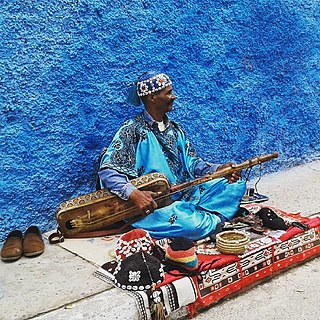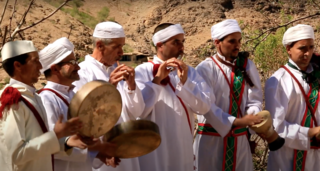
A pilgrimage is a journey to a holy place, which can lead to a personal transformation, after which the pilgrim returns to their daily life. A pilgrim is a traveler who is on a journey to a holy place. Typically, this is a physical journey to some place of special significance to the adherent of a particular religious belief system.
A marabout is a descendant of the Prophet Muhammad and a Muslim religious leader and teacher who historically had the function of a chaplain serving as a part of an Islamic army, notably in North Africa and the Sahara, in West Africa, and (historically) in the Maghreb. The marabout is often a scholar of the Qur'an, or religious teacher. Others may be wandering holy men who survive on alms, Sufi Murshids ("Guides"), or leaders of religious communities.
In Islam, Barakah or Baraka is a blessing power, a kind of continuity of spiritual presence and revelation that begins with God and flows through that and those closest to God.

A shrine is a sacred space dedicated to a specific deity, ancestor, hero, martyr, saint, daemon, or similar figure of respect, wherein they are venerated or worshipped. Shrines often contain idols, relics, or other such objects associated with the figure being venerated. A shrine at which votive offerings are made is called an altar.

A zawiya or zaouia is a building and institution associated with Sufis in the Islamic world. It can serve a variety of functions such a place of worship, school, monastery and/or mausoleum. In some regions the term is interchangeable with the term khanqah, which serves a similar purpose. In the Maghreb, the term is often used for a place where the founder of a Sufi order or a local saint or holy man lived and was buried. In the Maghreb the word can also be used to refer to the wider tariqa and its membership.

The Gnawa are an ethnic group inhabiting Morocco, that had been brought as slaves from the West African Sahel.

Tzadik is a title in Judaism given to people considered righteous, such as biblical figures and later spiritual masters. The root of the word ṣadiq, is ṣ-d-q, which means "justice" or "righteousness". When applied to a righteous woman, the term is inflected as tzadeket/tzidkaniot.

According to a 2009 Pew Research Center report, 93.1% of Turkmenistan's population is Muslim. Traditionally, the Turkmen of Turkmenistan, like their kin in Uzbekistan and Afghanistan are Sunni Muslims. Shia Muslims, the other main branch of Islam, are not numerous in Turkmenistan, and the Shia religious practices of the Azerbaijani and Kurdish minorities are not politicized. The great majority of Turkmen readily identify themselves as Muslims and acknowledge Islam as an integral part of their cultural heritage, but some support a revival of the religion's status primarily as an element of national revival.

Moulay Idriss, Moulay Driss Zerhoun or simply Zerhoun is a town in the Fès-Meknès region of northern Morocco, spread over two hills at the base of Mount Zerhoun. It is famous for being the site of the tomb of Idris I, the first major Islamic ruler of Morocco, after whom the town is named. It is located near Meknes and overlooks the ruins of Volubilis a few kilometers away.
A Sheikh or shaykh, of Sufism is a Sufi who is authorized to teach, initiate and guide aspiring dervishes in the Islamic faith. He has laid all his worldly desires to rest thru the one intense desire for knowing the love of God his beloved. The sheik is vital to the path of the novice Sufi, for the sheik has himself travelled the path of mysticism. Viewed as the spiritual master, the sheik forms a formal allegiance (bay'a) to the disciple of Sufism and authorizes the disciple's travels and helps the disciple along the mystical path. Islamic tradition focuses on the importance of chains and legitimization. In Sufism, sheiks are connected by a continuous spiritual chain. This chain links every previous Sufi sheik, and eventually can be traced back to the Successors, and in later times to the Prophet himself. As Sufism grew, influential shayks began to acquire spiritual centers and waypoints known as khanqah, ribat, and zaouia. Sheikhs duplicate the Prophetic realities, and are also expected to perform and act as an intermediary between the Creator and the created, since the sheikh has arrived close to God through his meditations and spiritual travels. There are several types of such sheikh.

The Isawiyya is a religious Islamic mystical brotherhood founded in Meknes, Morocco, by Sheikh al-Kamil Mohamed al-Hadi ben Issa (1465–1526), best known as the Shaykh Al-Kamil, or "Perfect Sufi Master". The terms Aissawiyya (`Isawiyya) and Aissawa (`Isawa), derive from the name of the founder, and respectively designate the brotherhood and its disciples.

The holiest sites in Islam are located in the Arabian Peninsula. While the significance of most places typically varies depending on the Islamic sect, there is a consensus across all mainstream branches of the religion that affirms two cities as having the highest degree of holiness, in descending order: Mecca, and Medina. Mecca's Al-Masjid al-Haram, Al-Masjid an-Nabawi in Medina are all revered by Muslims as sites of great importance.

Aḥwash is a Shilha style of collective performance, including dance, singing, poetry and percussion, from southern Morocco. The ahwash is performed on the occasion of local festivals as a celebration of the community.

Religious tourism, spiritual tourism, sacred tourism, or faith tourism, is a type of tourism with two main subtypes: pilgrimage, meaning travel for religious or spiritual purposes, and the viewing of religious monuments and artefacts, a branch of sightseeing.
The name Qureshi, also known as Quraysh, Quraishi, Qurayshi and various other spellings, originates from the Arabic name قريشي, denoting membership in the esteemed Quraish tribe of Mecca, in the Hejaz, present day Saudi Arabia. The prophet Muhammad was also born into the Qureshi tribe of Mecca.

The Zawiya of Moulay Idris II is a zawiya in Fez, Morocco. It contains the tomb of Idris II, who ruled Morocco from 807 to 828 and is considered the main founder of the city of Fez. It is located in the heart of Fes el-Bali, the UNESCO-listed old medina of Fez, and is considered one of the holiest shrines in Morocco. The current building experienced a major reconstruction under Moulay Ismail in the early 18th century which gave the sanctuary its overall current form, including the minaret and the mausoleum chamber with its large pyramidal roof.

The Chiadma region, situated on the Atlantic coast of Morocco between Safi and Essaouira, is known for its distinct cultural and geographical features. It is characterized by its rich history and unique landscape, encompassing diverse communities and traditions.
Sidi Ahmed Ou Moussa, also spelled SidiAhmad u Musa was a marabout, Muslim saint and spiritual leader of Tazerwalt in the Sous region of Morocco.

The Khalili Collection of Hajj and the Arts of Pilgrimage is a private collection of around 5,000 items relating to the Hajj, the pilgrimage to the holy city of Mecca which is a religious duty in Islam. It is one of eight collections assembled, conserved, published and exhibited by the British scholar, collector and philanthropist Nasser Khalili; each collection is considered among the most important in its field. The collection's 300 textiles include embroidered curtains from the Kaaba, the Station of Abraham, the Mosque of the Prophet Muhammad and other holy sites, as well as textiles that would have formed part of pilgrimage caravans from Egypt or Syria. It also has illuminated manuscripts depicting the practice and folklore of the Hajj as well as photographs, art pieces, and commemorative objects relating to the Hajj and the holy sites of Mecca and Medina.

Mawsim or moussem, waada, or raqb, is the term used in the Maghreb to designate an annual regional festival in which worshippers usually combine the religious celebration of local Marabouts or Sufi Tariqas, with various festivities and commercial activities. These are very popular events, often attended by people from very distant places.














